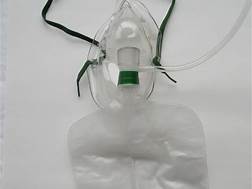A nurse is caring for a client who has been receiving oxygen via simple face mask for 6 hours. Which of the following assessment findings indicates that oxygen therapy has been effective?
PaO2 80 mmHg.
SaO2 88%.
RR 32/min.
BP 160/90 mmHg.
The Correct Answer is A
The correct answer is choice a. PaO2 80 mmHg.
Choice A rationale:
PaO2 (partial pressure of oxygen in arterial blood) of 80 mmHg indicates that the oxygen therapy has been effective. Normal PaO2 levels range from 75 to 100 mmHg, so a value of 80 mmHg suggests adequate oxygenation.
Choice B rationale:
SaO2 (arterial oxygen saturation) of 88% is below the normal range (typically 95-100%) and indicates hypoxemia, suggesting that the oxygen therapy has not been fully effective.
Choice C rationale:
A respiratory rate (RR) of 32 breaths per minute is significantly higher than the normal range (12-20 breaths per minute) and indicates respiratory distress, suggesting that the oxygen therapy has not been effective.
Choice D rationale:
Blood pressure (BP) of 160/90 mmHg is elevated and indicates hypertension, which is not a direct measure of the effectiveness of oxygen therapy. This finding does not provide information about the patient’s oxygenation status.
Nursing Test Bank
Naxlex Comprehensive Predictor Exams
Related Questions
Correct Answer is B
Explanation
Choice A rationale:
Although a tracheostomy collar provides oxygen directly to the trachea, the advantage specified in the question is related to the ability to breathe room air when disconnected from the oxygen source.
Choice B rationale:
This is the correct answer because a tracheostomy collar has an opening that allows the patient to breathe room air when the oxygen source is disconnected. This feature enables the patient to participate in activities without continuous oxygen delivery, promoting mobility and reducing the feeling of being tethered to an oxygen supply.
Choice C rationale:
A tracheostomy collar does not provide the highest fraction of inspired oxygen (FiO2) among low-flow systems. High-flow systems, such as non-rebreather masks or venturi masks, typically provide the highest FiO2.
Choice D rationale:
A tracheostomy collar does not deliver a fixed amount of oxygen independent of the patient's breathing pattern. Instead, it provides supplemental oxygen in response to the patient's inspiratory effort, which is a characteristic of low-flow oxygen delivery systems.
Correct Answer is ["A","B","E"]
Explanation

The correct answer is choice a, b, and e.
Choice A rationale:
A non-rebreather mask is designed to deliver a high concentration of oxygen, often deemed the highest among low-flow systems. It achieves this through a reservoir bag that is filled with pure oxygen, which the patient breathes in without the dilution of room air.
Choice B rationale:
This mask has one-way valves that prevent the patient from rebreathing exhaled carbon dioxide. The exhaled air exits through side ports, ensuring that only oxygen from the reservoir is inhaled.
Choice C rationale:
While a non-rebreather mask delivers a high concentration of oxygen, it does not provide a consistent and precise oxygen delivery compared to devices like a Venturi mask, which are designed to deliver a specific and constant oxygen concentration.
Choice D rationale:
The design of a non-rebreather mask does not allow room air to enter through the exhalation ports. The one-way valves are there to ensure that exhaled air does not enter the reservoir bag and that room air does not mix with the oxygen being inhaled.
Choice E rationale:
By delivering a high concentration of oxygen and preventing the rebreathing of exhaled gases, a non-rebreather mask minimizes the risk of carbon dioxide retention, which can be a concern with other oxygen delivery systems that allow for the rebreathing of a portion of exhaled air.
In summary, the non-rebreather mask is advantageous for its ability to deliver a high concentration of oxygen and prevent the rebreathing of exhaled air, which also minimizes the risk of carbon dioxide retention. It is not designed for precise oxygen delivery, nor does it allow the mixing of room air during inhalation.
Whether you are a student looking to ace your exams or a practicing nurse seeking to enhance your expertise , our nursing education contents will empower you with the confidence and competence to make a difference in the lives of patients and become a respected leader in the healthcare field.
Visit Naxlex, invest in your future and unlock endless possibilities with our unparalleled nursing education contents today
Report Wrong Answer on the Current Question
Do you disagree with the answer? If yes, what is your expected answer? Explain.
Kindly be descriptive with the issue you are facing.
